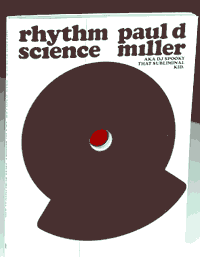 Rhythm Science, by Paul D. Miller, AKA DJ Spooky that Subliminal Kid, is a fascinating and challenging book. It explores Miller’s ideas about Rhythm Science – the creation of art from the flow of patterns in culture.
Rhythm Science, by Paul D. Miller, AKA DJ Spooky that Subliminal Kid, is a fascinating and challenging book. It explores Miller’s ideas about Rhythm Science – the creation of art from the flow of patterns in culture.
The book focuses on the role of the DJ as a metaphor for the artists in today’s culture. DJ’s are sampling, collaging and creating new works from elements of pop culture, and Miller has been on the leading edge of this. DJing and sampling offer new artistic tools, but also bring them cutting-edge controversy.
Ultimately, it’s about the tension between slavery and freedom, in life, in culture and in art, tieing together African-American heritage with the ideas underlying the art of DJing.
The book is an intellectual tour-de-force. Miller’s writing style adopts the free-form collage and sudden shifts of DJ music. This can at times make it a challenge to digest. He switches from theory to autobiography to history, throwing in reference to Nietzsche and the Wu-Tang Clan as he goes along. As a result, the writing is often dense, disjunct and the threads that connect sentences may not be readily apparent.
Miller puts it this way: “DJ-ing is writing, writing is DJ-ing. Writing is music, I cannot explain this any other way. Take Nietzsche, for instance, whose brilliant texts are almost musical. Obviously, you feel the rhythm inside a great poet’s stanzas, but it’s there within the great philosophers’ paragraphs as well. So many media and cultural techniques of interpretation coexist – reading watching, listening, surfing, dancing – that this textual/sonic synasthesia demands a great deal from us.”
Rhythm Science does demand a great deal from the reader. Miller’s range of references is massive, and he throws things together without trying to connect the dots for the reader. Nevertheless, the book is a compelling read for anyone interested in DJ culture and the ideas and issues that surround art in the digital age.

Rhythm Science is also a work of art. Designed by COMA, the book alternates spreads of glossy pages and matte pages. The main text runs through the matte spreads. The glossy spreads feature illustrations and quotes that comment or highlight on elements within the main text.
The book is bound with a CD by Miller that showcases his DJ style. It’s an aural exploration of the ideas in the book. The book is designed with a hole drilled through it that highlights the CD spindle bound into the back of the book. The CD isn’t a DJ mix in the popular sense, but more of a rhythmic sound collage. Miller takes DJing to the edge; both of what’s legal and of what’s accessible to a general audience. Just as Miller’s text is dense and freeform, the CD is all over the place.
The music has an old-school feel in the way that Miller uses samples. Most modern sample-based music tends to take a recognizable quote from a popular piece and loop that to create a groove for rapping or jamming over. Miller’s music imagines an alternate world where ideas and art are unfettered by copyright concerns.
Of course, we live in a world where artists have to deal with legal issues surrounding what can be created, shared and sold. Rhythm Science confronts us with these issues. While it doesn’t provide an answer to the questions that digital culture raises, it explores them in a compelling way.
Preview Rhythm science via Hypnotext.
